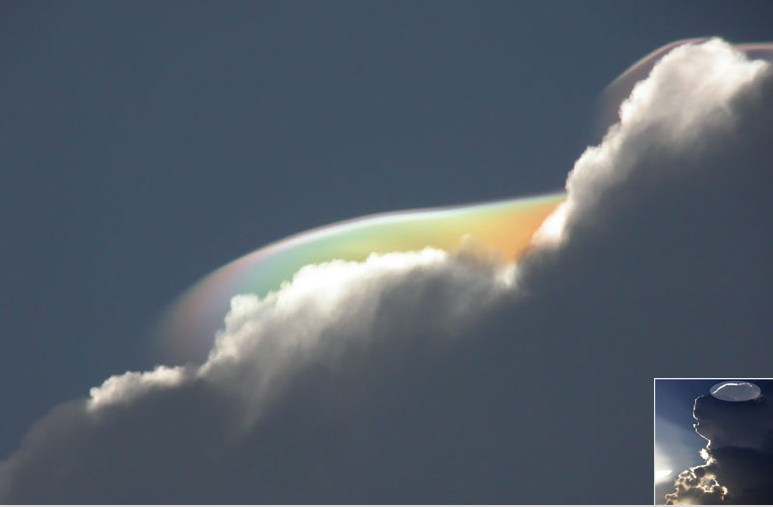Iridescence in pileus cloud
Iridescence in Pileus Clouds: A Mesmerizing Atmospheric Phenomenon
Have you ever gazed up at the sky and been captivated by the vibrant colors shimmering through the clouds? This enchanting display is known as iridescence, and it often occurs in a specific type of cloud called a pileus cloud, also known as a "mushroom cap" cloud. In this article, we will explore the mesmerizing world of iridescence in pileus clouds and unravel the science behind this captivating atmospheric phenomenon.
What are Pileus Clouds?
Pileus clouds form above cumulus clouds when warm, moist air rises and causes the cumulus clouds to tower upwards. As these cumulus clouds grow vertically, they sometimes push up a layer of moist air above them. This layer of air expands as it is forced into lower pressure surroundings and cools adiabatically. The water vapor in the air suddenly condenses, forming a misty veil-like layer of droplets above the cumulus clouds - the pileus cloud.
The Ideal Conditions for Iridescence
Iridescence occurs when light interacts with tiny water droplets or ice crystals suspended in the atmosphere. In the case of pileus clouds, these droplets are formed suddenly and are often of similar size, creating an ideal environment for iridescence to occur. The uniformity in droplet size allows for the constructive interference of light waves, resulting in the vivid display of colors.
The Science Behind Iridescence
When sunlight passes through the droplets in a pileus cloud, it undergoes a process called refraction. Refraction causes the light waves to bend as they enter the droplets and then again as they exit. This bending of light is responsible for the separation and dispersion of colors, similar to what occurs when light passes through a prism.
As the bent light waves exit the droplets, they interfere with each other, creating a phenomenon known as interference. The interference of light waves can either reinforce or cancel each other out, depending on their relative phase. This interference produces the striking colors observed in iridescent clouds.
The Colorful Display
Iridescence in pileus clouds often manifests as bands or patches of vivid colors, ranging from shimmering blues and greens to vibrant pinks and purples. These colors are a result of the constructive interference of specific wavelengths of light. The exact colors observed can vary depending on factors such as the size of the droplets, the angle of sunlight, and the observer's position.
Observing Iridescence in Pileus Clouds
To witness the captivating beauty of iridescence in pileus clouds, one must be in the right place at the right time. These atmospheric displays are relatively rare and fleeting, making them all the more special to witness. Here are a few tips for observing iridescence in pileus clouds:
- Look for cumulus clouds with visible vertical growth.
- Pay attention to any misty or veil-like layers forming above the cumulus clouds.
- Observe the sky when the sun is low on the horizon, as this provides the best angle for the sunlight to interact with the cloud droplets.
- Be patient and keep an eye out for any sudden bursts of vibrant colors within the cloud formations.
The Magic of Iridescence
Iridescence in pileus clouds is a reminder of the wonders that exist in our atmosphere. It serves as a testament to the intricate interplay between light, water droplets, and atmospheric conditions. Witnessing this magical phenomenon can leave us in awe of the natural world and inspire us to delve deeper into the mysteries of our atmosphere.
Conclusion
Iridescence in pileus clouds is a breathtaking display of colors that occurs when light interacts with uniformly sized water droplets suspended above cumulus clouds. This phenomenon, resulting from the refraction and interference of light waves, creates a mesmerizing spectacle for those fortunate enough to witness it. So, next time you find yourself gazing up at the sky, keep an eye out for the enchanting iridescence in pileus clouds and let yourself be transported into a world of vibrant hues and atmospheric wonder.

Iridescence in Florida pileus clouds. Imaged in July '03 by David LaPuma (site) using a Leica Televid 77 APO spotting scope. The inset shows the area of the main image atop a towering cumulus cloud. Pileus or "mushroom cap" clouds are formed above cumulus. During the day warm moist air in cumulus rises and the clouds tower upwards. Sometimes their vertical growth pushes up a layer of moist air above them. The air layer expands as it is forced up into lower pressure surroundings and adiabatically cools. The water vapour in it suddenly condenses forming a misty veil-like layer of droplets above the cumulus - pileus cloud. Any cloud formed suddenly has all its droplets of similar size - ideal for iridescence or a corona. Image ©2003 David LaPuma
Note: this article has been automatically converted from the old site and may not appear as intended. You can find the original article here.
Reference Atmospheric Optics
If you use any of the definitions, information, or data presented on Atmospheric Optics, please copy the link or reference below to properly credit us as the reference source. Thank you!
-
<a href="https://atoptics.co.uk/blog/iridescence-in-pileus-cloud/">Iridescence in pileus cloud</a>
-
"Iridescence in pileus cloud". Atmospheric Optics. Accessed on November 19, 2024. https://atoptics.co.uk/blog/iridescence-in-pileus-cloud/.
-
"Iridescence in pileus cloud". Atmospheric Optics, https://atoptics.co.uk/blog/iridescence-in-pileus-cloud/. Accessed 19 November, 2024
-
Iridescence in pileus cloud. Atmospheric Optics. Retrieved from https://atoptics.co.uk/blog/iridescence-in-pileus-cloud/.